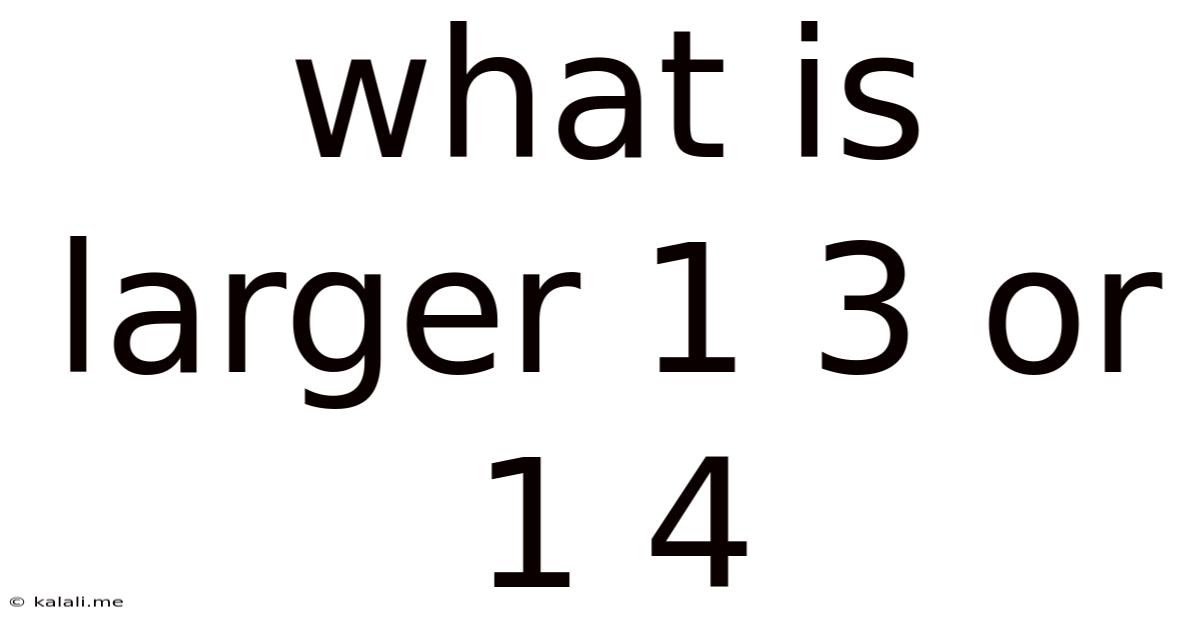What Is Larger 1 3 Or 1 4
Kalali
Aug 25, 2025 · 5 min read

Table of Contents
Unveiling the Giant: A Deep Dive into Comparing 1/3 and 1/4
This seemingly simple question – which is larger, 1/3 or 1/4? – belies a wealth of mathematical concepts and practical applications. While the answer might seem immediately obvious to some, understanding why one fraction is larger than the other unlocks a deeper appreciation for fractions, decimals, ratios, and their role in everyday life. This article will explore this comparison in detail, providing multiple approaches to understanding the relationship between 1/3 and 1/4, and extending the discussion to broader mathematical principles.
Understanding Fractions: A Quick Refresher
Before delving into the comparison, let's revisit the fundamental concept of fractions. A fraction represents a part of a whole. It consists of two key components:
- Numerator: The top number, indicating the number of parts we have.
- Denominator: The bottom number, indicating the total number of equal parts the whole is divided into.
In our case, we are comparing 1/3 (one-third) and 1/4 (one-quarter). Both fractions have a numerator of 1, meaning we are considering one part of a whole. However, the denominators differ, indicating that the wholes are divided into different numbers of parts.
Method 1: Visual Representation
A powerful way to compare fractions is through visual aids. Imagine two identical pizzas.
- Pizza 1: Cut into 3 equal slices. 1/3 represents one of these slices.
- Pizza 2: Cut into 4 equal slices. 1/4 represents one of these slices.
By observing the pizzas, it's visually apparent that the slice from Pizza 1 (1/3) is larger than the slice from Pizza 2 (1/4). This visual representation provides an intuitive understanding of the comparison without complex calculations.
Method 2: Converting to Decimals
Converting fractions to decimals offers another approach to comparison. To convert a fraction to a decimal, simply divide the numerator by the denominator.
- 1/3 = 0.3333... (a repeating decimal)
- 1/4 = 0.25
Comparing the decimal representations, 0.3333... is clearly larger than 0.25. This confirms that 1/3 is greater than 1/4.
Method 3: Finding a Common Denominator
A more mathematically rigorous method involves finding a common denominator for both fractions. This involves finding a number that is divisible by both 3 and 4. The least common multiple (LCM) of 3 and 4 is 12.
- We convert 1/3 to an equivalent fraction with a denominator of 12: (1 x 4) / (3 x 4) = 4/12
- We convert 1/4 to an equivalent fraction with a denominator of 12: (1 x 3) / (4 x 3) = 3/12
Now, comparing 4/12 and 3/12, it is evident that 4/12 (equivalent to 1/3) is larger than 3/12 (equivalent to 1/4).
Method 4: Using Number Lines
Visualizing fractions on a number line provides another effective comparison method. Plot both fractions on a number line from 0 to 1. You'll observe that 1/3 is positioned to the right of 1/4, indicating that 1/3 is greater.
Extending the Understanding: Implications and Applications
The seemingly simple comparison of 1/3 and 1/4 opens doors to a wider understanding of fractional arithmetic and its practical applications.
Real-world Applications:
- Sharing Resources: Imagine dividing a cake among three people (1/3 each) versus four people (1/4 each). Each person in the group of three receives a larger portion.
- Measurement and Proportion: In construction, cooking, or any field involving precise measurements, understanding the relative sizes of fractions is crucial for accuracy and consistency.
- Data Analysis: Fractions are fundamental to interpreting data, particularly when dealing with percentages and proportions.
Further Mathematical Explorations:
- Comparing Fractions with Different Numerators: The methods outlined above can be extended to compare fractions with numerators other than 1. The key is to find a common denominator or convert to decimals.
- Inequalities: The comparison of 1/3 and 1/4 can be expressed as an inequality: 1/3 > 1/4. Understanding inequalities is essential for solving mathematical problems and understanding relationships between numbers.
- Fraction Operations: Understanding the relative sizes of fractions is foundational for performing more complex operations such as addition, subtraction, multiplication, and division of fractions.
Beyond Fractions: Connecting to Decimals and Percentages
The comparison between 1/3 and 1/4 extends to decimals and percentages, further illustrating the interconnectedness of these mathematical concepts.
- Decimals: As shown earlier, 1/3 is approximately 0.333 and 1/4 is 0.25. The decimal representation clearly shows the difference in magnitude.
- Percentages: Converting the fractions to percentages, 1/3 is approximately 33.33% and 1/4 is 25%. Again, the percentage representation reinforces that 1/3 is larger.
Conclusion: A Simple Question, Profound Implications
The question "What is larger, 1/3 or 1/4?" might seem trivial at first glance. However, exploring this question through various mathematical approaches provides a solid foundation for understanding fractions, decimals, and their practical applications. By grasping the underlying concepts, we gain valuable skills applicable to various fields, from everyday tasks to complex mathematical problems. The seemingly simple comparison of these two fractions serves as a powerful gateway to a deeper understanding of the world of numbers. The ability to accurately compare fractions is not merely an academic exercise; it's a fundamental skill that underpins many aspects of quantitative reasoning and problem-solving. Mastering this concept paves the way for tackling more complex mathematical challenges with confidence and precision.
Latest Posts
Latest Posts
-
How Do You Say Spring Break In Spanish
Aug 25, 2025
-
How Much Does 12 Oz Of Beer Weigh
Aug 25, 2025
-
How Much Does Naked And Afraid Contestants Make
Aug 25, 2025
-
6 Ounces Of Chocolate Chips In Cups
Aug 25, 2025
-
What Is 5 To The Sixth Power
Aug 25, 2025
Related Post
Thank you for visiting our website which covers about What Is Larger 1 3 Or 1 4 . We hope the information provided has been useful to you. Feel free to contact us if you have any questions or need further assistance. See you next time and don't miss to bookmark.